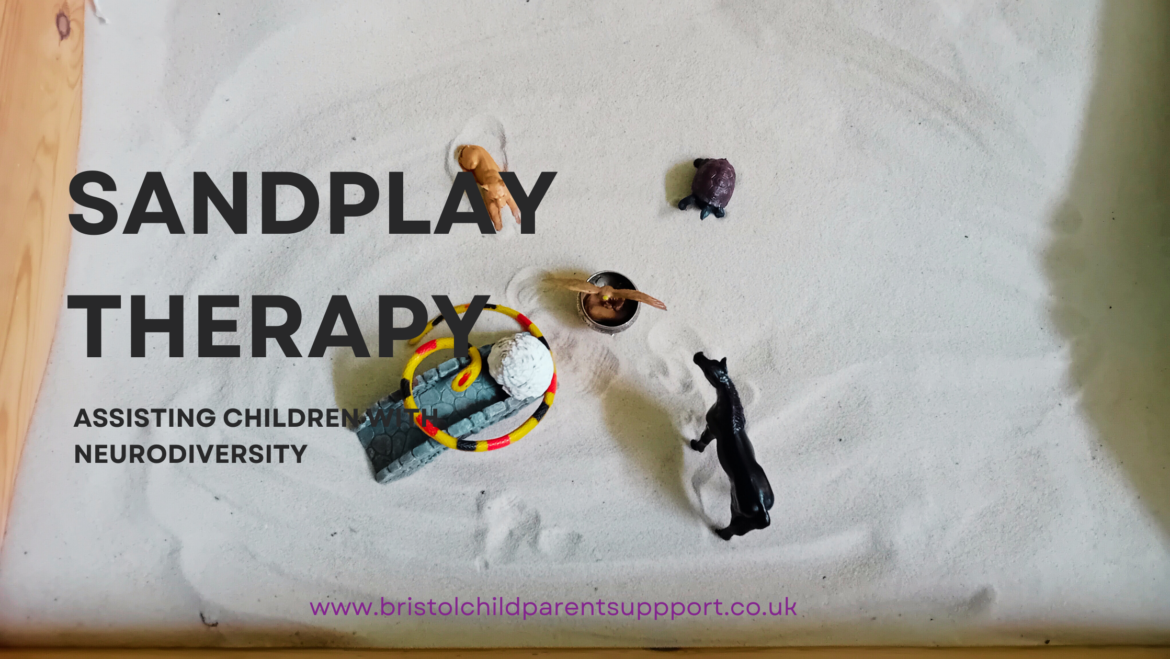As a parent, you want to do everything you can to help your child. When they’re struggling, it can be heartbreaking to watch and you may feel helpless.
“If you have a neurodiverse child and are considering therapy, you may have heard of CBT and other talk therapies. However, these methods may not be suitable for everyone, especially those who are neurodiverse or have experienced trauma.”. Additionally, young children may struggle with traditional talking therapy methods.
But don’t worry, there are alternative approaches to therapy that can be just as beneficial. One approach that I find particularly helpful in my practice is Sandplay Therapy. It’s a unique and creative way to engage with your child and enhance communication.
This blog explores the concept and offers tips for using it to improve parent-child communication.
What is Sandplay Therapy?
Sandplay therapy is a form of therapy where children use a tray filled with sand and various miniature objects to create scenes and stories. It is often called the World Technique, originating from Margaret Lowenfeld (1890-1973) and further developed by Frau Dora M. Kalff (1904-1990). I trained in it many years ago at the Institute for Arts in Therapy and Education in London.
The purpose of sandplay therapy is to provide a safe therapeutic space for children to express and explore their thoughts, emotions, and experiences. It allows them to communicate and process their inner world in a non-verbal and symbolic way. By playing with sand and manipulating objects, children can express their inner struggles, conflicts, and longings,
What does Sandplay Therapy involve?
Generally, children do not have much power or choice in their lives. During sandplay therapy, children can take an active role in their healing process. Through repetition, individuals relive their experiences, aiding in their understanding and acceptance of what they have gone through. In sandplay therapy, symbols act as a vessel for a child’s emotions. A child can use sand and symbols to express their emotions and work through them in a safe way. This can help them process and incorporate their feelings over time.
The therapist observes the child’s internal world and helps them understand their emotions and experiences. Through this playful approach, children can promote healing, self-discovery, emotional growth, and integration of their thoughts and feelings. It can also help them develop problem-solving skills, boost self-esteem, and improve their ability to manage their emotions.
Who can Sandplay Therapy help?
Sandplay therapy is particularly helpful for young people who struggle to express and talk about their feelings. Many children are unable to verbalise emotional states, particularly in the face of trauma or neurodiversity. Furthermore, every child is developing the ability to communicate and control their emotions due to their developing emotional brain. It is important to keep in mind that their emotional brain does not fully develop until they are about 24 years old. Hence, while it can benefit many children, it can be especially beneficial for individuals who are neurodiverse, have learning challenges, or have experienced trauma.
I recently finished a long piece of therapy with a child who had ADHD and other contributing difficulties. The Sandplay method helped them process their understanding of the world and helped them overcome challenges with focus, attention, and anxiety. Thus allowing for a smooth transition to senior school. However, it’s important to note that sandplay therapy should be used as part of a comprehensive treatment plan for ADHD, including other therapeutic interventions and support from parents and teachers.
Sandplay therapy can be beneficial for children with ADHD and Learning Diificulties in several ways:
- Non-directive and sensory-focused: Sandplay therapy provides a non-directive and sensory-focused approach, allowing children with ADHD to engage in a calming and structured activity. Manipulating the sand can provide a calming and soothing tactile experience, while also aiding in developing patience and coping with frustration. This can help in improving focus and regulating sensory input.
- Self-expression and emotional regulation: Children with ADHD and learning difficulties often struggle with emotional regulation and expressing their feelings. Sandplay therapy provides a safe and non-threatening space for them to express their emotions and experiences through the creation of scenes and stories. It slows down communication too, giving time and space to organise thoughts, which can help with practicing better impulse control. This can help them develop a better understanding of their emotions and learn healthy ways to regulate and manage them.
- Symbolic representation: Sandplay therapy uses symbols and metaphors, allowing children to represent their inner world and experiences in a symbolic way. This can aid children with ADHD who struggle to articulate their thoughts and emotions, allowing them to communicate and gain understanding of their own experiences.
- Enhancing executive functioning skills: Children with ADHD and learning difficulties often struggle with executive functioning skills such as planning, organising, and problem-solving. Sandplay therapy can help improve these skills as children engage in creating scenes and staying with narratives, requiring them to plan, organise, and make decisions about the placement and movement of objects in the sand.
- Self-esteem and self-confidence: Engaging in sandplay therapy can boost self-esteem and self-confidence in children with ADHD and learning difficulties. As they create and manipulate their own narratives and scenes, they gain a sense of control and mastery over their environment. Additionally, this can help improve their self-image and belief in their own abilities.
Additional ways Sandplay Therapy may help children who have suffered trauma
It can be particularly beneficial for children who have experienced trauma. Here’s how it can help them:
- Non-verbal expression: Children who have experienced trauma may struggle to put their feelings into words. Sandplay therapy provides a non-verbal outlet for them to express their emotions.
- Sense of control: Trauma can leave children feeling powerless and out of control. In sandplay therapy, they have the opportunity to take charge and create their own world within the sand tray. This sense of control can be empowering and help them regain a sense of agency over their experiences.
- Emotional healing: Through the process of creating and interacting with the sand scenes, children can begin to explore and process their traumatic experiences. The therapist observes and supports the child’s internal exploration, helping them gain insight into their own feelings and experiences. This can lead to emotional healing, integration, and a sense of resolution.
When would Sandplay Therapy not be suitable
Given all the above points, there are certain situations or conditions where it may not be the most suitable approach. As a result, sandplay therapy may not be recommended:
- Severe cognitive impairment: children with severe cognitive impairments may have difficulty understanding and engaging in the symbolic nature of sandplay therapy. They may struggle to comprehend the purpose and process of the therapy, limiting its effectiveness.
- Sensory sensitivities: Some individuals with sensory sensitivities may find the tactile experience of playing with sand overwhelming or distressing. In these situations, alternative forms of art/ therapy that are not as focused on sensory experiences may be more suitable.
- Timing and Support of the Therapeutic Approach: All therapy should be supported. There are some occasions when therapy is not advised in the first instance. You can read more here, https://bristolchildparentsupport.co.uk/what-to-expect-fees/.
- Sometimes, a young person does not show interest or engagement in the sandplay process or therapy. It may not be the right therapeutic approach for them. In such cases, other therapeutic modalities that align better with their interests and preferences should be considered. Most therapists like myself have a range of therapeutic tools to use. If a child is not ready, then I often offer parenting advice in the first instance. For example, there is evidence to show that parent therapy can just be as helpful. You can read more about this in my blog Myth-Busting Anxiety.
How could you use the skills to help your child communicate thier fears

As a parent, you can use expressive play, which involves using toys and objects to create narratives and act out emotions, can be an effective tool in helping children process their fears. By engaging in imaginative play, children can express their feelings in a safe and non-threatening way.
If your child has a fear, allow them to take control of the situation and find a resolution. For example, if your child is afraid of monsters under the bed, suggest they create a story where they become the hero and defeat the monsters using their own ideas and strategies. You can also desensitise them to the scary part. For example, if your child is worried about intruders, they can imagine funny scenarios, such as intruders slipping on goo or marbles.
In Conclusion
If you feel your child needs to work through some issues and would benefit from sandplay therapy, contact me for an initial consultation. Furthermore, if your organization is interested in receiving therapeutic instruction on creative therapies and sandplay, do contact me.
If you enjoyed this blog post and found it helpful or inspiring. Please share it with your friends on social media by clicking on the icons on the side. Thank you for visiting my website!
Disclaimer: The information provided here is for educational purposes only and should not be considered a substitute for professional advice or therapy.
The content provided is not intended to diagnose, treat, or cure any mental health condition or replace the guidance of a licensed therapist or healthcare provider. It is important for parents to consult with a qualified mental health professional to assess their child’s specific needs and determine the most appropriate therapeutic approach. Using sandplay therapy or any other therapeutic modality should be based on individual circumstances and professional recommendations.



